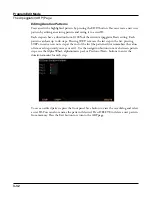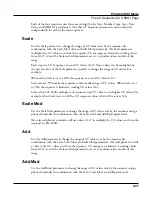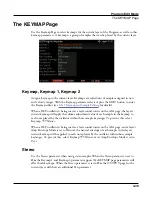
Program Edit Mode
The Arpeggiator (ARP) Page
3-27
Shift Patterns are most easily used and understood when triggered by only one key at a
time. One way to prevent triggering from multiple keys is to use one of the Latch types
1NoteAuto, 1NoteAutoLow, or 1NoteAutoHi when using a shift pattern. Triggering shift
patterns from one key allows the pre-programed patterns to sound like what you would
expect from their names (otherwise the results can be unpredictable). If no other keys are
playing, patterns will start over each time a key is pressed (there are some exceptions to this
when using Arpeggiator Latch settings other than “Keys,” though a newly triggered pattern
will always start at step 1).
Editing Shift Patterns
You can edit the highlighted pattern by pressing the EDIT button. You can create a new user
pattern by editing an existing pattern and saving it to a user ID.
In the Shift Pattern editor, pressing STEP- removes the last step in the list, pressing STEP+
inserts a new note step at the end of the list. Use the cursor to move between pattern steps,
use the alpha wheel, alphanumeric pad, or plus/minus buttons to enter the note shift amount
for each step. You can set a step to a value of “none” by entering -127 and then scrolling
down one more step. A step with the value “none” causes the arpeggiator to play nothing for
that step, allowing you to create rhythmic patterns by using “none” to leave spaces.
Use the CHANNEL/LAYER/ZONE/TRACK buttons to change the direction in which
pattern steps are played (indicated by Up, Down, or Flat on the right of the top line). With
pattern direction set to Up, the pattern plays starting at step one and moving up through
each step towards step 48. With pattern direction set to Down, the pattern starts at step one,
but then moves to the last step and continues to move backwards through the steps down
towards step 1 in the octave below the first note played. When the pattern direction is set to
Up or Down, the pattern will repeat transposed in the next higher or lower octave (limited
by the ARP page Shift Limit parameter). Patterns set to Flat play without transposition, in
which case the Shift Limit parameter can be used to restrict note range.
To save an edited pattern, press the front panel Save button to view the save dialog and select
a user ID. You can also rename the pattern if desired. Press DELETE to delete a user pattern
from memory. Press Exit to return to the ARP page.
Summary of Contents for Flash Play PC4
Page 1: ... It s the sound Part Number 910587 002 Rev B ...
Page 9: ... ix MIDI Implementation A 1 Specifications B 1 Index I 1 ...
Page 289: ... 8 40 ...
Page 328: ... 10 7 ...
















































